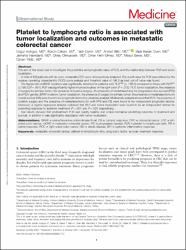Platelet to lymphocyte ratio is associated with tumor localization and outcomes in metastatic colorectal cancer

Göster/
Erişim
info:eu-repo/semantics/openAccessAttribution-NonCommercial 4.0 Internationalhttps://creativecommons.org/licenses/by-nc/4.0/Tarih
2021Yazar
Açıkgöz, ÖzgürÇakan, Burçin
Demir, Tarık
Bilici, Ahmet
Öven, Bala Başak
Hamdard, Jamshid
Olmuşçelik, Oktay
Ölmez, Ömer Fatih
Şeker, Mesut
Yıldız, Özcan
Üst veri
Tüm öğe kaydını gösterKünye
Açıkgöz, Ö., Çakan, B., Demir, T., Bilici, A., Öven, B. B., Hamdard, J. ... Yıldız, Ö. (2021). Platelet to lymphocyte ratio is associated with tumor localization and outcomes in metastatic colorectal cancer. Medicine, 100(44). https://dx.doi.org/10.1097/MD.0000000000027712Özet
The aim of this study was to investigate the predictive and prognostic value of PLR, and the relationship between PLR and tumor localization. A total of 229 patients with de-novo metastatic CRC were retrospectively analyzed. The cutoff value for PLR was defined by the receiver operating characteristic (ROC) curve analysis and threshold value of 196.5 as best cut-off value was found. The higher rate of BRAF mutation was significantly detected for patients with PLRhigh (> 196.5) compared to those with PLRlow (<= 196.5) (P = .001). PLR was significantly higher in tumors located on the right colon (P = .012). PLR, tumor localization, the presence of surgery for primary tumor, the presence of curative surgery, the presence of metastasectomy for progression-free survival (PFS) and PLR, gender, BRAF mutation, tumor localization, the presence of surgery for primary tumor, the presence of metastasectomy for overall survival (OS) were found to be prognostic factors by univariate analysis. Multivariate analysis showed that PLR, the presence of curative surgery and the presence of metastasectomy for both PFS and OS were found to be independent prognostic factors. Moreover, a logistic regression analysis indicated that PLR and tumor localization were found to be an independent factors for predicting response to systemic treatment (P P = .023 respectively). Our results showed that pretreatment PLR was readily feasible and simple biomarker predicting response to treatment and survival, in addition it was significantly associated with tumor localization.
WoS Q Kategorisi
Q3Scopus Q Kategorisi
Q3Kaynak
MedicineCilt
100Sayı
44Koleksiyonlar
- Makale Koleksiyonu [3751]
- PubMed İndeksli Yayınlar Koleksiyonu [4203]
- Scopus İndeksli Yayınlar Koleksiyonu [6522]
- WoS İndeksli Yayınlar Koleksiyonu [6585]


















